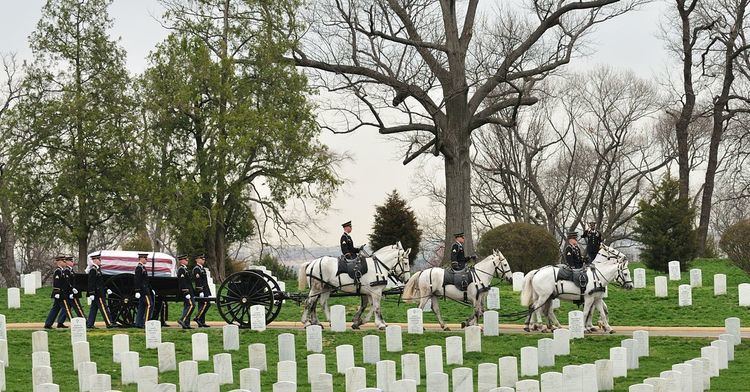 | ||
A military funeral in the United States is a memorial or burial rite given by the U.S. military for a Soldier, Marine, Sailor, Coast Guardsman, or Airman who died in battle, a veteran, or other prominent military figures or a president. A military funeral may feature guards of honor, the firing of volley shots as a salute, drumming and other military elements, with a flag draping over the coffin.
Contents
In the United States, the United States Army Military District of Washington (MDW) is responsible for providing military funerals. "Honoring Those Who Served" is the title of the program for instituting a dignified military funeral with full honors to the nation's veterans.
As of January 1, 2000, Section 578 of Public Law 106-65 of the National Defense Authorization Act mandates that the United States Armed Forces shall provide the rendering of honors in a military funeral for any eligible veteran if requested by his or her family. As mandated by federal law, an honor guard detail for the burial of an eligible veteran shall consist of no fewer than two members of the Armed Forces. One member of the detail shall be a representative of the parent armed service of the deceased veteran. The honor guard detail will, at a minimum, perform a ceremony that includes the folding and presenting of the flag of the United States to the next of kin and the playing of Taps which will be played by a lone bugler, if available, or by audio recording. Today, there are so few buglers available that the United States Armed Forces often cannot provide one. However, federal law allows Reserve and National Guard units to assist with funeral honors duty when necessary.
Eligibility
Generally, federal law allows for military funeral honors for all veterans who were discharged under circumstances "other than dishonorable." Funeral directors will require the veteran's DD Form 214 to establish eligibility.
Those who are eligible for military funerals and full honors in the United States include the following:
Ceremony
In the United States, there are several types of military funerals such as those performed at Arlington National Cemetery, which include and omit certain components depending on the status of the deceased (active, retired, veteran, rank/occupation).
Standard honor military funerals include the following:
Full honor military funerals include all standard honors in addition to the following:
Armed forces military funerals include all standard and full honors in addition to the following:
When a spouse or other dependent of a current or former member of the United States Armed Forces is buried, the military service in which the primary party served will provide a casket team and a chaplain. No other military honors will be rendered unless the spouse served in the military.
The flag of the United States draped over the casket is meticulously folded twelve times by a total of six honor guards, three on each side of the casket.
Often, three spent shell-casings, each representing one of three volleys, are slipped into the folds of the flag before its presentation to the next of kin. This is a violation of the United States Flag Code, Title 4 U.S Code, Sec. 8(h), which states that "(t)he flag should never be used as a receptacle for receiving, holding, carrying or delivering anything." When the flag is completely folded, the stars point upwards, which remind Americans of their national motto, In God We Trust. After the flag is completely folded and tucked in, it takes on the appearance of a tricorne hat, reminding Americans of the soldiers who served under General George Washington, and the sailors and Marines who served under Captain John Paul Jones, who were followed by their comrades and shipmates in the United States Armed Forces.
An honor guard composed of one or more branches of the United States Armed Forces, presents the flag to the next of kin. The presenter, if possible a member of the same service as the deceased, will generally kneel while presenting the folded flag, with the straight edge of the flag facing the recipient. The presenter then recites the following wording, which was standardized on April 20, 2012:
On behalf of the President of the United States, the United States (Army, Marine Corps, Navy, Air Force or Coast Guard ), and a grateful nation, please accept this flag as a symbol of our appreciation for your loved one's honorable and faithful service.
Ramp ceremonies
A "ramp ceremony" is a memorial ceremony, not an actual funeral, for a soldier killed in a war zone held at an airfield near or in a location where an airplane is waiting nearby to take the deceased's remains to his or her home country. The term has been in use since about 2005 and became common during the wars in Iraq and Afghanistan.
